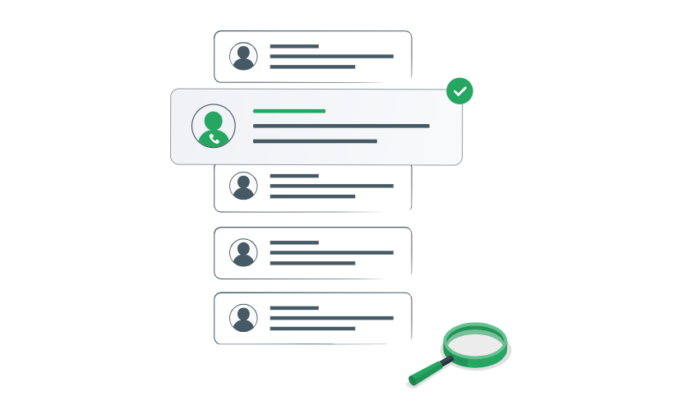There’s a difference between protecting your privacy and using it as a shield for manipulation. In 2025, this line is more visible than ever – especially when tools like ClarityCheck.com are involved.
What happens when someone uses anonymity not for safety, but to obscure their intentions? What if the number messaging about a “business opportunity” is tied to failed ventures or domain-hopping? What if a contact won’t say who they are – and switches numbers every few days?
ClarityCheck.com doesn’t guess. It doesn’t harvest personal messages. But it does surface what’s already visible: disconnected signals, forgotten traces, loosely connected identifiers. Sometimes that’s enough to spot a pattern.
When privacy is a performance
The language of privacy often suggests protection. But some people use it to create distance, mislead, or erase responsibility.
Across ClarityCheck reviews on Trustpilot and other platforms, users describe moments when this performance fell apart. A contact avoiding calls. A seller who wouldn’t confirm their name. A recruiter who insisted on chat-only communication. Subtle inconsistencies prompted a check. What followed was a string of flags: abandoned sites, linked aliases, or spam complaints.
Privacy wasn’t violated – it was examined. That distinction matters.
What ClarityCheck.com shows
ClarityCheck.com works as a reverse lookup. A user enters a number. The platform pulls together public, structured data: names, domain associations, reports, and mentions. Results appear quickly. A detailed report is available through a low-cost trial that continues as a subscription if not canceled.
You don’t need an account to start. There’s no sync, no permissions prompt. According to many ClarityCheck reviews, this process feels intentional: open enough to be useful, restrained enough to stay ethical.
The shape of someone’s trail
Someone might switch numbers weekly, stay off social media, and avoid direct answers. But they still leave traces – old listings, mentions, flagged domains.
ClarityCheck connects those traces. It doesn’t draw conclusions. But it lets the user see repetition, context, inconsistencies. A number mentioned on fraud forums. A domain connected to that number. A shared alias.
This isn’t surveillance. It’s synthesis. It offers just enough to question – or confirm.
Why users check in the first place
People don’t usually run lookups without a reason. The reviews say as much:
- Parents seeing unknown numbers on their kids’ phones
- Freelancers approached by vague clients
- Tenants receiving unexpected requests for deposits
The data from ClarityCheck isn’t framed as definitive. It’s functional. When someone refuses to share their name, a neutral report showing shared data points can be enough.
Nothing to hide, or everything to hide?
People who emphasize privacy while omitting basic identifiers invite scrutiny. ClarityCheck users describe being pushed to trust blindly – then checking a number and realizing they weren’t being cautious enough.
Some contacts claim they “don’t use email,” or that they’re “between phones.” When that’s followed by demands for money, urgency, or vagueness, users pause. Then they search.
That moment of hesitation – that’s when tools like ClarityCheck shift the balance.
It doesn’t reveal, it confirms
The tool doesn’t dig deep. It doesn’t access private messages or location data. It confirms what’s already in public view. When patterns emerge – repeat mentions, connected domains, overlapping profiles – they tell a story. One the person behind the number chose not to.
This is what many ClarityCheck reviews describe: not a dramatic discovery, but a quiet confirmation.
Checking is not spying
Running a search isn’t an invasion. It’s a filter. A protection step. ClarityCheck doesn’t publish results or store lookups. It doesn’t alert the number being searched. It just helps users see what already exists online.
No one is owed blind trust. But everyone is responsible for the impression they create.
When context is missing, people look elsewhere
Modern communication is fragmented. Without in-person meetings or verifiable contacts, people rely on tools like ClarityCheck to check the gaps.
- Was that recruiter real?
- Is this number connected to anything suspicious?
- Have others seen this contact before?
These are the questions ClarityCheck helps answer. Not fully, but clearly enough.
When behavior suggests intent
Reviewers describe interactions where everything felt slightly off. Not criminal – just strange. Unwillingness to speak by phone. No record of the business name. Odd timing. Vague links.
ClarityCheck didn’t label those contacts. It showed overlap, repetition, or lack of presence. For many users, that was the reason to say no – or to ask more questions.
Privacy is a boundary, not a disguise
ClarityCheck doesn’t exist to punish privacy. It exists to protect people when privacy is used to create confusion. If you choose to reveal nothing, don’t expect people to ignore the warning signs.
People who use tools like ClarityCheck aren’t trying to expose. They’re trying to navigate.
And sometimes, the only way to move forward is to look twice before replying.
Trust takes more than a clean number
In 2025, people understand that a phone number isn’t proof. ClarityCheck isn’t about verification. It’s about triangulation: finding enough evidence to proceed or withdraw.
And when someone’s story has holes, or their signals don’t match their claims, a simple lookup might be the clearest message you’ll get.
ClarityCheck.com doesn’t force a decision. It offers the data. What you do with it is up to you.








